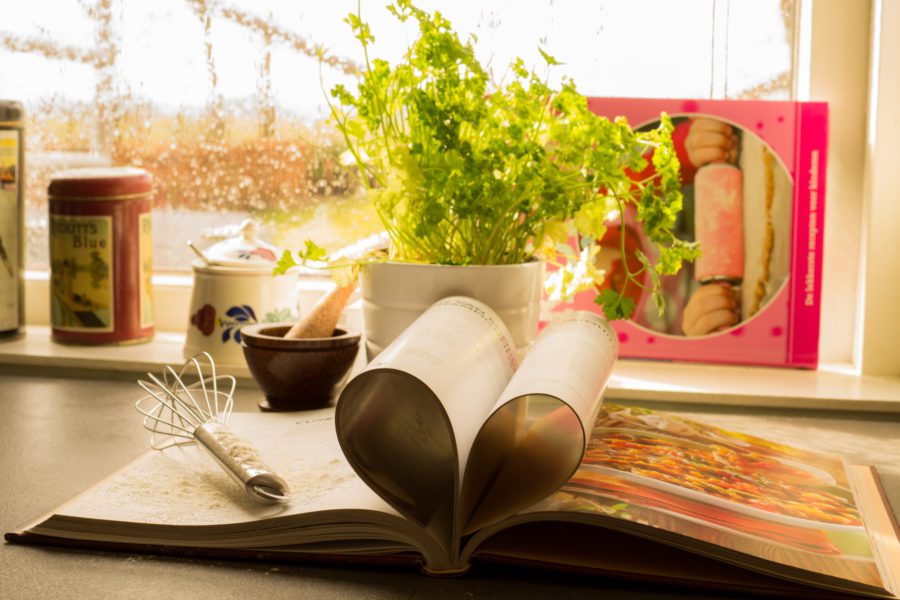One passion I share with many of my clients is the joy of cooking. There is nothing more delightful than bringing a random assortment of ingredients together and creating something magical. We love exchanging recipes, talking about how this or that is made, what tricks you could use or how delicious it tastes.
Another thing we share is the challenge of keeping our recipes organized. Whether it’s cookbooks, notecards passed down from your mother, recipes cut out of a magazine or a clipping from a cooking website, we are all blessed — and inundated — with a wide array of delicious “roadmaps” to culinary nirvana.
But how to organize it all? I’m here to serve up a few tips on each type of recipe you may own.

COOKBOOKS
Long gone are the days when you only had a few recipe books on your kitchen shelf like The Joy of Cooking or Julia Child’s masterpiece Mastering the Art of French Cooking; now there are scores of different cookbooks featuring a certain type of cuisine (Italian, Mexican, Indian, pizza, etc.), the time of day it is eaten (breakfast, brunch, lunch, dinner, dessert), the style of cooking (grill, wok, slow cooker, sous vide), a certain holiday (Thanksgiving, Christmas, Hanukkah, Easter, Passover) and so on.
If you like to cook, a cookbook is one of the best and easiest gifts for friends to give you. And since you like to cook, you probably have more than your fair share of cookbooks – many that you never use, or that contain only one or two recipes you like.
Step 1: Purge
Purge the books you don’t use. One year, I donated over 40 cookbooks to my son’s school auction, many that were used for “cooking basket” gift items.
Step 2: Donate or Toss
If there are only a few recipes you like in a book, take a photo, copy or scan the recipes. Then add this book to your donation pile.
Step 3: Assign a Space
Identify and delineate the space that is going to hold your cookbooks: is it a shelf, a cabinet or space on your countertop? Whatever the location, be prudent that your collection doesn’t expand past that designated area.
Step 4: Categorize
Organize your books within that space based on the categories you now have: by cuisine, time of day, cooking technique or holiday – however it seems to make the most sense to you so you can easily locate that cookbook again.

RECIPE NOTECARDS
If you have recipe notecards – the traditional way recipes were kept in a kitchen that were either passed down from relatives or shared by friends – you may already have a notecard box to hold them. If you use most of those notecards and can keep the box on your shelf or in your cabinet dedicated to cookbooks, great! If not, follow Step 2 above: pull out your favorite recipes and recycle the rest. You can also now give away the box and make more room in your cabinet for other things.
Save the notecards that you are keeping for the next category.

RECIPE PAPER CLIPPINGS
It’s so easy to clip a recipe when you see it. Your mouth waters! Your heart sings! And the anticipated rave reviews are already ringing in your ears!
But recipes that are clipped from magazines or newspapers are often the biggest challenge when it comes to organizing recipes. First, there is no consistency between size or shape of the clipped recipe. Second, the paper is probably tattered, yellowing or in pretty poor condition due to the way it is stored. And third: There. Are. So. Many.
Step 1: Categorize
Categorize your recipes. For this exercise, you can be a bit more granular since you’re the one cooking and making the decisions here. How will you remember where you filed a particular recipe? Sort in a way that makes most sense for you: for example, by type of meal, type of meat (beef, pork or poultry), type of cuisine and so forth.
Step 2: Contain
Contain your recipes.

Option 1: Store the recipes in a binder, with tab dividers for each section and plastic pages to contain and protect your recipes.
Option 2: Store the recipes in a file drawer or file box, with folders for each category. In this solution, the recipes can be loose in the file folder.

DIGITAL RECIPES
Even easier than clipping recipes from the newspaper, clipping recipes from the web can become an addiction. No paper, no mess, no clutter! The options are limitless! Why not save every recipe that sounds good with a remote chance that you’ll make it . . . someday?
Exactly. While that someday may one day come, the majority of “somedays” never come. Now’s the time to review what you’ve saved and make some honest decisions with yourself about what stays and what goes.
There are a variety of ways to clip or save recipes from the web. Most common methods are to bookmark them in your web browser, pin them to Pinterest, use a program like OneNote in Microsoft or clip to an app like Evernote. My top choice of these is Evernote.
When I read the food/cooking blogs that I follow on my iPhone, iPad or computer, I can easily save any recipe that looks good to my Evernote “Recipe” notebook. I have hundreds of recipes saved there – and the organization I have created in Evernote is very similar to the physical structure I have set up with my paper clippings, with one major distinction: tagging!
Tagging changes the entire ballgame of organizing your recipes:
- I tag by food category: e.g. meat, chicken, pasta, etc.
- I tag by time of day: e.g. breakfast, brunch, appetizer, etc.
- I tag by holiday: e.g. Christmas, Passover, New Year’s, etc.
- I tag my favorites.
- A recipe can have multiple tags: e.g. chicken, slow cooker, favorite – the best feature!
- I have a created a tag titled “new” so I know if I’ve made it before – or not.
- I immediately delete any recipes that were a fail.
With my digital recipe organization, I have found that I enjoy and actually prefer cooking with my iPad or iPhone – not only is it immediately accessible and portable, I can click back to the website to read comments and get tips about how to make the recipe better: more of this, less of that, cook longer, cook shorter, add this spice, skip the frying part, etc.
Whatever method you choose to organize your recipes, I hope these tips give you some inspiration to find the ones you love — and have more fun in the kitchen!
—
How do you organize your recipes? Any tricks you can share? Please let us know!



I love storing my recipes in Pepperplate, because I can edit them to the way I make them, while maintaining a link to the original (except for those I’ve entered from cookbooks or magazines, but I can at least indicate the source and note if I’ve made any changes).
Oh, how I love to learn about new products/services to keep us organized! Pepperplate sounds like a great kitchen tool — I just signed up. I’m loving the “Cook Mode” feature to prevent the screen from dimming on your device while you cook, which is constant source of agitation for me! Thanks so much for sharing, Janet. Happy cooking!
Purging cookbooks is one of those projects that tends to free up a lot of space. I keep giving away a couple every year. I finally realized that a couple of them only have one or two recipes that I like, so I took a photo and got rid of the clunky book. At the same time, I have resisted digitizing all of my recipes. There is something I love about holding and looking at paper. I think my eyes are rebelling against all of the screen time:)